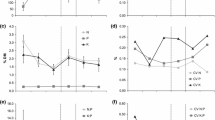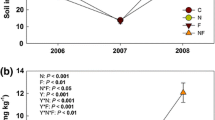Abstract
-
• In this study we analyzed heterogeneity in nutrient cycling induced by trees in Mediterranean annual grasslands, comparing years of higher and lower than average precipitation and analyzing the effects of two different solar radiation scenarios.
-
• Organic matter and consequently upper soil N, K, Ca and Mg were significantly greater in those locations receiving the highest levels of solar radiation, and as expected from many other studies in the literature, there was an increase in all macronutrients (except P) as well as pH below the canopy.
-
• Contrary to what was expected, plant nutrient concentrations did not directly reflect those found in the soil, with the exception of K. The studied grassland responded to increased nutrient availability by enhancing growth and changing botanical composition rather than by increasing plant nutrient concentrations. Hence, the total amount of accumulated nutrients in the ecosystem was larger below the tree than outside it, although this is mainly a consequence of plant growth enhancement. The levels of Ca, Mg, and Na in plants decreased during the driest year, and the N content was mostly determined by the composition of the grass.
-
• Temporal nutrient variability, particularly within-years, explained most of the variability in plant nutrient concentration, while spatial variability induced by trees was determined to be of secondary importance. These results are significant for ecosystem nutrient modelling.
Résumé
-
• Dans cette étude, nous avons analysé l’hétérogénéité du cycle des nutriments induite par les arbres dans les prairies méditerranéennes annuelles, en comparant les années à précipitations supérieures et inférieures à la moyenne et en analysant les effets de deux scénarios de rayonnements solaires différents.
-
• La matière organique et par conséquent N, K, Ca et Mg des horizons supérieurs du sol étaient significativement plus élevés dans les stations recevant le plus de rayonnement solaire. Comme prévu à partir de nombreuses autres études dans la littérature, une augmentation de tous les macronutriments (sauf P) et aussi du pH a été observée sous la canopée des arbres.
-
• Contrairement à ce qui était prévu, les concentrations de nutriments dans les végétaux n’ont pas reflété directement celles trouvées dans le sol, à l’exception de K. Les prairies étudiées ont répondu à un accroissement de la disponibilité en éléments nutritifs par une augmentation de la croissance et un changement de la composition botanique plutôt que par une augmentation des concentrations de nutriments dans les plantes. Par conséquent, les quantités totales de nutriments accumulées dans l’écosystème étaient plus importantes sous les arbres qu’en plein découvert, bien que cela soit principalement une conséquence de l’amélioration de la croissance des plantes. Les niveaux de Ca, Mg, et Na dans les plantes ont diminué au cours de l’année la plus sèche et la teneur en nutriments azotés était largement déterminée par la composition de l’herbe.
-
• La variabilité temporelle intra-annuelle des éléments nutritifs expliquait la plus forte part de la variabilité de la concentration en nutriments des plantes annuelles, tandis que la variabilité spatiale induite par les arbres était d’importance secondaire. Ces résultats sont importants pour la modélisation des éléments nutritifs dans les écosystèmes.
Similar content being viewed by others
References
Augusto L., Ranger J., Binkley D., and Rothe A., 2002. Impact of several common tree species of European temperate forests on soil fertility. Ann. For. Sci. 59: 233–253.
Barker A.V. and Pilbeam D.J., 2007. Handbook of plant nutrition, CRC, Taylor & Francis. Brady N.C. and Weil, R.R., 2002, The nature and properties of soils, 13th edition, Prentice Hall, NJ.
Brooker R.W., Maestre F.T., Callaway R.M., Lortie C.L., Cavieres L., Kunstler G., et al., 2008. Facilitation in plant communities: the past, the present, and the future. J. Ecol. 96: 18–34.
De Schrijver A., Geudens G., Augusto L., Staelens J., Mertens J., Wuyts K., Gielis L., and Verheyen K., 2007. The effect of forest type on throughfall deposition and seepage flux: a review. Oecologia 153: 663–674.
Escudero A., García B., Gómez J.M., and Luis E., 1985. The nutrient cyling in Quercus rotundifolia and Quercus pyrenaica ecosystems (“dehesas”) of Spain. Acta Oecol. Oecol. Plant. 6: 73–86.
Eviner V.T. and Chapin III F.S., 2003. Functional matrix: a conceptual framework for predicting multiple plant effects on ecosystem processes. Ann. Rev. Ecol. S. 34: 455–485.
Gallardo A., Rodríguez J.J., Covelo F., and Fernández Alés R., 2000. Soil nitrogen in a Dehesa ecosystem. Plant Soil 222: 71–82.
Gallardo A., 2003. Effect of tree canopy on the spatial distribution of soil nutrients in a Mediterranean Dehesa. Pedobiologia 47: 117–125.
Gea-Izquierdo G., Montero G., and Cañellas I., 2009. Changes in limiting resources determine spatio-temporal variability in tree-grass interactions. Agrofor. Syst. 76: 375–387.
Joffre R., Vacher J., De los Llanos C., and Long G., 1988. The dehesa: an agrosilvopastoral system of the Mediterranean region with special reference to the Sierra Morena area of Spain. Agrofor. Syst. 6: 71–96.
Koerselman W. and Meuleman A.F.M., 1996. The vegetation N:P ratio: a new tool to detect the nature of nutrient limitation. J. Appl. Ecol. 33: 1441–1450.
Ludwig F., de Kroon H., Prins H.H.T., and Berendse F., 2001. Effects of nutrients and shade on tree-grass interactions in East-African savannas. J. Veg. Sci. 12: 579–588.
Ludwig F., de Kroon H., Berendse F., and Prins H.H.T., 2004. The influence of savanna trees on nutrient, water and light availability and the understorey vegetation. Plant Ecol. 170: 93–105.
Montalvo M.I., García B., Luis E., and Gómez J.M., 1980. Influencia del arbolado sobre la composición química de la hierba. Anales de Edafología y Agrobiología 39: 1287–1305.
Montoya J.M., 1982. Efectos del arbolado de las dehesas sobre los factores ecológicos que actúan al nivel del sotobosque. Anales INIA/Serie Forestal 5: 61–85.
Moreno G., Obrador J.J., and García A., 2007. Impact of evergreen oaks on soil fertility and crop production in intercropped dehesas. Agric. Ecosyst. Environ. 119: 270–280.
Olea L., Paredes J., and Verdasco M.P., 1990–1991. Características y producción de los pastos de las dehesas del S.O. de la Península Ibérica. Pastos 20–21: 131–156.
Olea L. and San Miguel A., 2006. The Spanish dehesas: A traditional Mediterranean silvopastoral system linking production and nature conservation. Grassland Science in Europe 11: 3–13.
Pérez Corona M.E., García A., García B., and Vázquez de Aldana B.R., 1995. Patterns of aboveground herbage production and nutritional quality structure on semiarid grasslands. Commun. Soil Sci. Plant. Anal. 26: 1323–1341.
Pérez Corona M.E., Vázquez de Aldana B.R., García B., and García A., 1998. Variation in nutritional quality and biomass production of semiarid grasslands. J. Range Manage. 51: 570–576.
Puerto A., Rico M., Gómez G.J.M., García J.A., and Rodríguez R., 1984. Influencia de la encina sobre la composición química del estrato herbáceo. Stud. Oecol. V: 151–168.
Puerto A. and Rico M., 1988. Influence of tree canopy (Quercus rotundifolia Lam. and Quercus pyrenaica Willd.) on old field succession in marginal areas of Central-Western Spain. Acta Oecol. 9: 337–358.
Puerto A. and Rico M., 1992. Spatial variability on slopes of Mediterranean grasslands: structural discontinuities in strongly contrasting topographic gradients. Vegetatio 98: 23–31.
Puerto A. and Rico M., 1996. Trees as a homogenizing factor of the herbaceous community structure and nutrient content in Mediterranean grasslands. Agrochimica XL: 197–208.
Rhoades C.C., 1997. Single-tree influences on soil properties in agroforestry: lessons from natural forest and savanna ecosystems. Agrofor. Syst. 35: 71–94.
Rodá R., Retana J., Gracia C.A., and Bellot J. 1999. Ecology of Mediterranean evergreen oak forests, Springer-Verlag, Berlin, 373 p.
Schaetzel R.J. and Anderson S., 2006. Soil: genesis and geomorphology, Cambridge University Press.
Vázquezde Aldana B.R., García A., Pérez M.E., and García B., 2000. Nutritional quality of semi-arid grassland in western Spain over a 10 year period: changes in chemical composition of grasses, legumes and forbs. Grass Forage Sci. 55: 209–220.
Verbeke G. and Molenberghs G., 2000. Linear mixed models for longitudinal data, Springer-Verlag, New York.
Author information
Authors and Affiliations
Corresponding author
Rights and permissions
About this article
Cite this article
Gea-Izquierdo, G., Allen-Díaz, B., San Miguel, A. et al. How do trees affect spatio-temporal heterogeneity of nutrient cycling in mediterranean annual grasslands?. Ann. For. Sci. 67, 112 (2010). https://doi.org/10.1051/forest/2009091
Received:
Revised:
Accepted:
Issue Date:
DOI: https://doi.org/10.1051/forest/2009091




